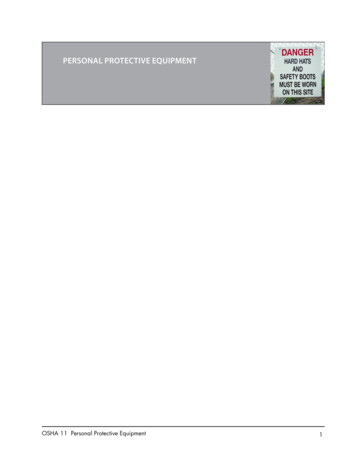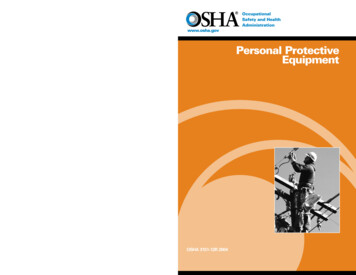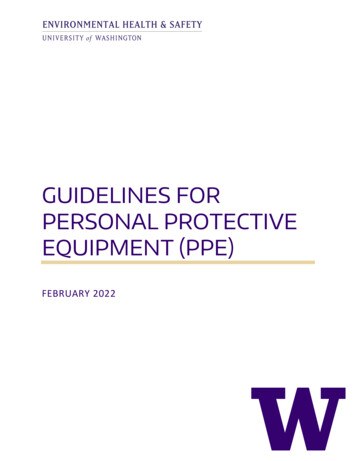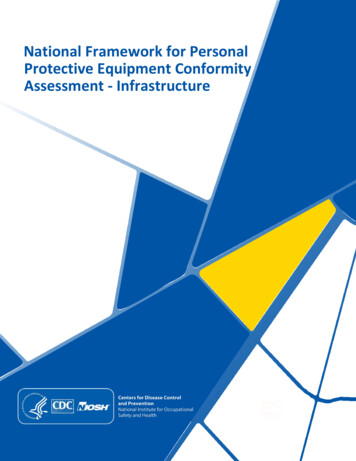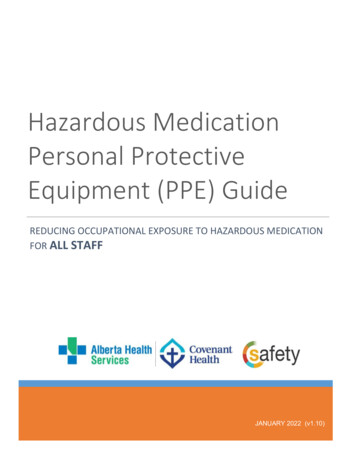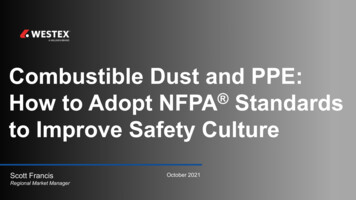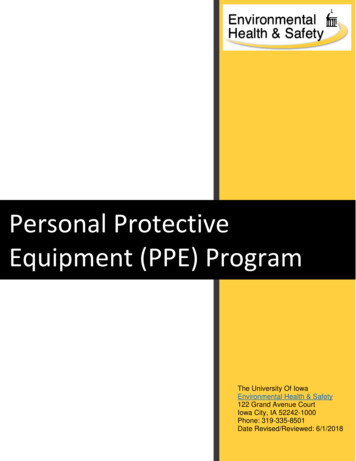
Transcription
Personal ProtectiveEquipment (PPE) ProgramThe University Of IowaEnvironmental Health & Safety122 Grand Avenue CourtIowa City, IA 52242-1000Phone: 319-335-8501Date Revised/Reviewed: 6/1/2018
Table of Contents1. Summary . 22. Scope . 23. Policy and Regulation. 24. Roles and Responsibilities . 25. Procedures . 36. Resources and Assistance . 5APPENDIX A - Forms. 6APPENDIX B - PPE Information and Training Guides. 7Eye and Face Protection . 8Protective Clothing . 9Gloves . 10Respiratory Protection . 11Hearing Protection . 12Foot Protection. 13Hard Hats . 14Electrical Protection . 15Fall Protection . 16APPENDIX C - CERTIFICATION FOR PPE TRAINING . 171 Page
1.SummaryPersonal protective equipment (PPE) is used to create a protective barrier between aworker and hazards in the workplace. PPE includes such equipment as chemicalresistant gloves, safety shoes, hard hats, safety glasses, respirators, and clothing suchas gowns and aprons.2.ScopeThese procedures are intended to: Assist departments and work units in completing hazard assessment surveys forPPE selection. Provide resources for employee information and training. Demonstrate compliance with safety regulations.3.Policy and RegulationUniversity of Iowa Operations Manual, Part III Human Resources: Division II Standards and Ethics, Chapter 16.4.d Policy on Ethics andResponsibilities for University of Iowa Staff Division VII Personal Injury and Injury Prevention, Chapter 33: PersonalProtective EquipmentGeneral Industry Occupational Safety and Health Regulations, 29 CFR 1910, Subpart I. General Requirements (1910.132) Eye and Face Protection (1910.133) Respiratory Protection (1910.134) Head Protection (1910.135) Fall Protection (1910.140 & 1910.23) Foot Protection (1910.136) Electrical Protective Equipment (1910.137) Hand Protection (1910.138)4.Roles and ResponsibilitiesDeans, Directors and Department Heads are responsible to: Designate and empower the department’s Health and Safety Coordinator (orProgram Coordinator or equivalent) and supervisors. Actively support these procedures within individual units. Ensure an environment where employees are encouraged to follow theseprocedures.The Department Health and Safety Coordinator is responsible to: Act as an administrative liaison between the department and EHS. Provide administrative oversight of health and safety within the department. Facilitate the correction of safety problems within the department.2 Page
Supervisors are responsible to: Implement these procedures. Assure that staff is aware of this program and provided with training andthe personal protective equipment. Maintain documentation and records as required.Employees are responsible to: Comply with these procedures and any further safety requirements set bysupervisors. Conduct assigned tasks in a safe manner, wear appropriate personal protectiveequipment, and obtain training and information.EHS is responsible to: Provide procedural guidelines, educational offerings, administrative consultationsand reviews, and select technical and field services. Exercise surveillance over health and safety issues at the University.5.ProceduresProcedures that Apply to All Work LocationsAll work locations except offices and classrooms are required to complete a hazardassessment to determine whether hazards are present or likely to be present that wouldrequire the use of PPE. Even if PPE will not be required, completion of the hazardassessment is still required.Appendix A links to forms to use to fulfill OSHA’s requirement for a written certificationof a hazard assessment. Shops, operations and maintenance, utility plants, businessservices, and academic areas that are not wet research labs should use the form“Certification of Hazard Assessment Form for PPE Use”. Research laboratories shoulduse the form “PPE - Research Laboratory Hazard Assessment Tool”.If it is determined that no hazards exist or are likely to exist for which PPE use would berequired, check the box that says “NONE – Hazards requiring personal protectiveequipment are not present or likely to be present”.A copy of the form should be kept on file in the department so a record of compliancecan be produced for a regulatory inspection or audit.Procedures that Apply Where PPE Use is RequiredAt work areas where the PPE hazard assessment survey determined that PPE use isrequired, procedures must be implemented for selection, use, maintenance, training,visitors, and periodic follow ups.Selection, Use and Maintenance ProceduresThe PPE Information and Training Guides in Appendix B provide generalconsiderations for the categories and types of PPE, what they are used for,3 Page
standards that govern their design, and guidelines for the wearing, limitations andcare of PPE.Only the appropriate type of PPE meeting certain specification criteria can be used.Therefore, when selecting protective clothing or equipment for specific chemical orbiological material, it is best to directly consult the safety data sheet and themanufacturer’s product specifications and testing data for that product. TheEnvironmental Health & Safety may also be contacted for assistance.Routine use PPE items such as gloves and goggles are available from UniversityGeneral Stores, Chem Stores, and BioChem Stores.The employer (i.e., the department, unit, shop or lab in charge of or in control of awork location) must also ensure that PPE appropriate for that work location isavailable to and used by visitors to that work location. Visitors should be briefed onuse of the PPE when it is provided to them.Training RequirementsInitial training includes two parts: general awareness training and departmenttraining.General Awareness TrainingThis part may be provided by the department, or the employee may complete EHS’sonline course. Employees working in research laboratories should take “PPEAwareness for Labs - W157CM”, and employees working at all other locationsshould take “PPE Awareness for Non-Labs - W156OS.”Department-Specific TrainingThis part must be provided by the employing unit to address PPE selections specificto the work area.Each employee that is required to use PPE must be trained on the following:1. When PPE is necessary.2. What PPE is required?3. How to properly put on, take off, adjust, and wear PPE.4. The limitations of the PPE.5. The proper care, maintenance, useful life and disposal of the PPE.Each employee must demonstrate an understanding of the training and the ability tohandle the PPE properly.The department must certify the training (keep a record) by documenting that theemployee received and understood the material presented. Choices for acceptablerecords include: The "Certification for PPE Training" form in Appendix C4 Page
Record of completion of EHS online training is included in the individual’s HRSelf Service Site “My Training”, and departments retain the completed sitespecific training and information form.Any alternative record that meets the requirements of OSHA standard1910.132(f) for written training certifications which include the name of theemployee trained, the date(s) of the training, and identification of the materialpresented in the training.Repeat or Recurring RequirementsThe OSHA standard on PPE does not have automatic annual repeatingrequirements. EHS recommends that training occur on annual or periodic basis.Hazard assessments and training must be added to the existing program for: A new or different hazard A new or different type of PPE A new process or procedureTraining only must be accomplished or repeated for: A new employee A previously trained employee who lacks understanding of PPE use6.Resources and AssistanceFor questions or assistance see “Contact Us” on EHS’s web site, or call 335-8501 toreach the appropriate person based on your work location and the nature of yourquestion.5 Page
APPENDIX A - FormsCertification of Hazard Assessment Form for PPE UsePPE - Research Laboratory Hazard Assessment Tool6 Page
APPENDIX B - PPE Information and Training GuidesPPE Information and Training Guides Eye and Face ProtectionProtective ClothingGlovesRespiratory ProtectionHearing ProtectionFoot ProtectionHard HatsElectrical ProtectionFall Protection7 Page
Eye and Face ProtectionPPE Information and Training GuideEye and Face ProtectionThe University of IowaPurposeEye and face protection shall be required where there is a reasonable probability that injury could beprevented by such protection. PPE shall be selected in accordance with Iowa OSHA 1910.133, Eye andFace Protection.Eye and Face Protection UseThe minimum types of PPE necessary for physical and chemical hazards are listed below:1. Safety glasses, as a minimum, are required where there is a potential of eyes being struck byprojectile objects. Side shields are required if there is a hazard from flying objects from the side.2. Direct vented goggles (those with perforated holes on the sides) are an acceptable substitute forsafety glasses with side shields.3. Chemical splash goggles (those with indirect ventilation on sides) are required where protection isneeded against chemical splashes or sprays. These may also be used where impact protection isrequired.4. Face shields are required where facial skin protection is needed. They can only be used inconjunction with eye protection. The face shield is not a substitute for the safety glasses orgoggles.5. Shaded eye/face protection is required for radiant energy sources from arc and gas welding,soldering and brazing, laser, ultraviolet, and infrared.Exposure to Bloodborne pathogensThe OSHA Bloodborne Pathogens Standard defines potential contamination as including generation ofsplashes, spray, splatter or droplets of blood or other potentially infectious materials called OPIM. Eyeand face protection must be worn when potential exists for contamination of mucous membranes. Sincethe goal is to provide protection of the eyes, nose and mouth, protection may consist of one of twochoices: 1) eye protection (that includes side shields) and a face mask, or 2) a chin length face shieldonly.Eye and Face Protection Equipment SourcesWhen prescription safety glasses are required, the purchase is handled through UI Optical with aninterdepartmental requisition. The eye exam cost is the employee’s responsibility.Eye and Face Protection Design StandardsPPE shall meet requirements specified in American National Standards Institute, Z87.1, Practice forOccupational and Educational Eye and Face Protection. This standard covers exposure related tophysical hazards and chemical hazards. This standard does not apply to Bloodborne Pathogens orprotective equipment for lasers, X-rays, gamma rays and microwaves. Users should contact themanufacturer or EHS for selection assistance.Eye and Face Protection Wear Factors and LimitationsWhen lenses become severely scratched or pitted they should be replaced. Frames and elastic bandsshould be replaced when they become worn or broken.Eye and face protection should be selected based on the hazard present as stated above.8 Page
Protective ClothingPPE Information and Training GuideProtective ClothingThe University of IowaPurposePersonal protective clothing is required where employees may be exposed to such hazards as toxic orcorrosive chemicals, biological pathogens, molten metal splashes, thermal extremes, etc. The protectiveclothing may take the form of aprons, coveralls, coats, pants, hats, hoods, sleeves, gloves, and totallyencapsulating chemical protective suits. An example of special clothing is a vest to reflect light for outdoornight workers.Clothing UseIt is important to select clothing based upon its ability to resist degradation and permeation caused bydifferent agents.In General: Wool and specially treated cotton clothing are fire-resistant and comfortable.Heavy fabrics protect against cuts and bruises from heavy, sharp or rough materials.Leather guards against dry heat and flame.Rubber protects against acids and chemicals.Synthetic materials may catch on fire more easily.Disposable suits of paper like material protect against dusty materials.Disposable or reusable suits for liquid or vapor protection should be evaluated on a case-by-casebasis.Clothing Design StandardsThe OSHA rule states that protective clothing shall be of safe design and construction for the work to beperformed. The clothing selected should be able to protect the body by preventing injury or impairmentthrough absorption or physical contact.Clothing Wear FactorsShall be provided and maintained in a sanitary and reliable condition. Defective or damaged clothingshould not be used.Clothing LimitationsGeneric chemical resistance information should be verified with the manufacturer since similar materials(e.g., nitrile) available from different manufacturers may vary widely in their performance depending uponthe particular manufacturing method and glove design.9 Page
GlovesPPE Information and Training GuideGlovesThe University of IowaPurposeGloves must be worn when there is the potential for injury or exposure to skin contact from chemicals,infectious agents, heat, cold, abrasive, and cutting objects.Glove UseNot all gloves are equally effective in preventing skin contact, especially from chemical exposures.Chemicals eventually permeate gloves; however, they can be used safely for specific time periods whenthe conditions of use and glove characteristics, i.e., thickness, permeation, rate and time, are known.EHS is also available for assistance with your glove selection.Glove Design StandardsAppropriate gloves are best selected by referring to glove specifications in laboratory or safety supplycatalogs. Chemical resistance information should be verified with each manufacturer since similarmaterials (e.g., nitrile) available from different manufacturers may vary widely in their performancedepending upon the particular manufacturing method and glove design.General information for gloves available from General Stores is provided in their catalog.The glove manufacturer or EHS may also be contacted.Glove Wear FactorsGloves must be cleaned after use and replaced periodically depending upon chemical permeability to thematerial handled. When gloves become torn or worn through by physical contact they should be replaced.Glove LimitationsGlove limitations are based upon the physical or chemical characteristics of the materials being handled,and the type and duration of work being performed.10 P a g e
Respiratory ProtectionPPE Information and Training GuideRespiratory ProtectionThe University of IowaNote: If you have or use respirators, other than surgical masks for patient protection, please contact EHSif your area has not had a respirator selection survey by EHS. OSHA requirements apply to bothrespirators required to be worn and those used voluntarily for comfort or convenience.PurposeRespirators are required to prevent occupational diseases caused by inhalation of contaminated air. Arespirator is any device used to protect an individual from the inhalation of contaminated air or fromexposure to hazardous atmospheres such as low oxygen. Respirators include dust masks, chemicalcartridge respirators, PAPR (powered air purifying respirators), airlines, and SCBA (self-containedbreathing apparatus). Respirators do not include staff use of surgical masks for patient or productprotection.Respirator UseEHS must evaluate the respirator selection and will also assist in implementing respirator programelements such as evaluations, monitoring, training, fit-testing, and model written programs. Departmentsare responsible for maintaining their respirator programs.Respirator StandardRequired elements of the Respiratory Protection Standard are:1. Exposure evaluation to determine protection needed.2. Written program to document program procedures.3. Medical evaluations prior to respirator use. The University Employee Health Clinic provides thisservice for employees. Students should go through the Student Health Service for this evaluation.4. Respirator selection based on the exposure evaluation.5. Fit testing prior to use.6. Training prior to use.7. Recordkeeping including employee names, type of respirators selected fit testing, and training.These records must be maintained indefinitely by departments.11 P a g e
Hearing ProtectionPPE Information and Training GuideHearing ProtectionThe University of IowaNote: If you have or use hearing protection, please contact EHS if your area has not had a noise surveyby EHS.PurposeHearing protectors are required to prevent noise induced hearing loss. Hearing protection devices reducethe noise energy reaching and causing damage to the inner ear. Ear muffs and earplugs are the mostcommon types of PPE.Hearing Protection UsePPE for hearing protection is required for employees who are exposed to noise levels equal to or greaterthan 85 decibels averaged over an eight-hour period.Purchase SourcesGeneral Stores stocks a selection of hearing protectors, which can be obtained with a safety requisitionform.Hearing Protection StandardWhen employees are exposed to noise levels over 85 dBA/TWA, the standard requires that a HearingConservation Program be implemented. Required elements are:1. Noise evaluations.2. Selection of hearing protection.3. Initial training.4. Annual refresher training.12 P a g e
Foot ProtectionPPE Information and Training GuideFoot ProtectionThe University of IowaPurposeSafety shoes are required where the potential for serious injury to the foot may result from an employee'sdaily job duties. Foot injuries may occur in areas where there are rolling or falling objects, objects piercingthe sole, or where feet are exposed to electrical hazards. These guidelines are not intended to apply tofunctions performed by an employee on a rare or special occasion, unless the risk of foot injury is great.Use of Safety ShoesIn general, the need for safety shoes is indicated if work involves: Hand carrying rigid equipment or objects weighing 20 lbs. or more up and down stairs Lifting or carrying rigid equipment or objects on a floor or level surface where:20 to 49 lbs. or lifted or carried object is above knee level, or,50 lbs. or more is lifted or carried at any elevation. Use of wheeled carts or dollies that have a load of 50 lbs. or more. Use of mechanical lifting equipment such as overhead hoists to lift and move material. Areas where sharp objects may puncture the feet. Areas with manual material handling carts or heavy pipes that could roll over the feet. Frequenting areas where others are engaged in the above activities.Shoe Design StandardsSafety shoes and boots meeting the ANSI Z41 most current standard provide both impact andcompression protection. Special types of shoes can also be obtained that provide puncture protection, oroffer electrical insulation from foot contact with electrical sources.Shoe Purchase SourcesEach department is responsible for procuring safety shoes with outside vendors for its employees. Shoesmay be paid for with a departmental Pcard or Purchase Order, or the department may reimburse theemployees for shoes purchased directly. Departments should decide on a reasonable amount they willreimburse for shoes based upon their departmental budgets.Shoe Wear FactorsDamaged or defective shoes should be replaced.Shoe LimitationsSafety shoes only protect the toes and not the instep or metatarsals.13 P a g e
Hard HatsPPE Information and Training GuideHard HatsThe University of IowaPurposeHard hats are required when working in areas where there is a potential for injury to the head from fallingobjects. In addition, hard hats designed to reduce electrical shock are required when working nearexposed electrical conductors that may contact the head.Specialty types of hard hats include those with miner's light attachments, reflective stripe for night work,face shields for welders, and attachments for visors or earmuffs.Use of Hard HatsHard hats should be used when falling object hazards may result from activities with proximity to: persons or operations where accidental dropping or loss of material, tools, equipment or otherarticles could lead to a head injury; a barricaded or posted demolition or construction area where head hazards exist; objects stored on shelves, platforms, etc. that may fall and cause head injury; or overhead exposed energized conductors nearby.Hard Hat Design StandardsAll hard hats must comply with ANSI Z89.1, American National Standard for Personal Protection Protective Headwear for Industrial Workers - Requirements.Hard Hat Types: The two types of hard hats are defined by the area of the head that is protected. Type I offers protection to the top of the head and is commonly used in the United States. Type II offers protection to the top and sides of the head and is commonly used in Europe.ANSI Hard Hat Classes Hard Hat Classes: The three classes are based on the level of protection theyprovide from electrical hazards. Class G (General) hard hats are rated for 2,200 volts (equivalent to the old Class A). Goodimpact protection, but limited voltage protection. Class E (Electrical) hard hats are rated for 20,000 volts (equivalent to the old Class B). Protectagainst falling objects, high-voltage shock/burns. Class C (Conductive) Designed for comfort, offer limited protection. Protects heads that maybump against fixed objects, but do not protect against falling objects or electrical shock.Labeling RequirementsEach hard hat must have the following information clearly marked inside the hat: Manufacturer's name ANSI standard that the hard hat conforms with, such as "ANSI Z89.1-2009" ANSI type (type I or II) and class designation (G, E or C) Size range for fitting Date of manufactureHard Hat Wear Factors and LimitationsHard hat headbands and chin and nape straps should be adjusted to keep the hat comfortably on thehead. Liners or sweatbands can be added for warmth or cooling. The shell or other parts of the hat shouldbe replaced when they become damaged. Clean hats by dipping in hot water with detergent, scrub theshell and rinse in clear hot water. Cleaning solvents may damage the shell.14 P a g e
Electrical ProtectionPPE Information and Training GuideElectrical ProtectionThe University of IowaPurposeDepending on the job task to be performed, PPE for electrical work generally includes safety glasses,face shields, hard hats, safety shoes, insulating (rubber) gloves with leather protectors, insulatingsleeves, and flame-resistant (FR) clothing. OSHA Standard 1910.137 (Electric Protective Equipment)addresses rubber insulating electrical equipment such as gloves, sleeves, blankets, covers, line hose andmatting which is required when employees must work on energized lines and other parts of electricalequipment. In addition, NFPA 70E outlines specific PPE that should be worn depending the hazard/riskcategory classification. In these situations, such equipment is often the only line of defense againstelectric shock and arc flash. Only “Qualified Persons” are allowed to work on “live” electrical parts.Electrical PPEEmployees working in areas where electrical hazards are present shall be provided with, and shall use,protective equipment that helps to protect the worker from electrical shock and arc flash hazards. Allemployees that are trained in accordance with and perform work within NFPA 70E shall wear theappropriate PPE. The PPE shall be designed and constructed for the specific part of the body to be protected andfor the work to be performed.Shock protection: The appropriate nonconductive protective PPE shall be selected and used toprotect the electrical worker from injury due to electrical shock from live parts. For example,voltage rated gloves are required to protect the hands from possible electric shock while testingan electrical component for the presence of voltage.Arc flash protection: The appropriate flame-resistant PPE shall be selected and used to minimizethe thermal effects of an electrical arc flash on the electrical worker.Use of Equipment for Electrical ProtectionElectrical protective equipment for this type of work must be selected and used to meet OSHA 1910.137requirements. This specialized PPE must be tested, and certified as tested, at intervals as stated in thestandard. Regular routine inspection is required for equipment defects. The protective equipment must becleaned and properly stored.Standard on Electrical Protective EquipmentOSHA 1910.137 details requirements that must be followed for the selection, use, and maintenance ofspecialized electrical protective equipment.Note: The number of University employees covered by this standard is very limited.15 P a g e
Fall ProtectionPPE Information and Training GuideFall ProtectionThe University of IowaPurposeFall Protection is any equipment, device or system that prevents an accidental fall or that mitigates theeffect of such a fall. OSHA requires that fall protection be provided at elevations of four feet in generalindustry (1910.140 & 1910.23) and six feet in the construction industry (1926.500-503). University ofIowa employees should wear fall protection wherever the potential to fall four feet or more exists.Personal Fall Protection SystemsActive Fall Protection – requires individual involvement, training and understanding of equipment andproper use of harnesses, lanyards, ropes, D-rings, SRL’s, etc. Restraint systems Arrest systems Positioning systems Ladder Safety systemsRestraint (harness and restraint system; “the leash”) Restraint systems prevent workers from falling by keeping them from reaching an area where thefall hazard exists. Securing the individual to an anchorage point using a lanyard short enough to prevent theperson’s center of gravity from reaching the fall hazard. Leading edge work where there are no guardrails. Within aerial boom lifts so the center of gravity cannot move beyond the bucket rails. Restraint is typically the preferred fall protection system when the environment allows because afall is completely avoided.Fall Arrest - these systems require the most extensive work to properly implement, train, and maintain. A – Anchorage: Primary support structure that can sustain a fall and suspend an individual untilrescue. B – Body Support: Full body harness to distribute the forces on the body during a fall. C – Connector: Devices that connect the harness to the anchorage point. D – Descent/Rescue: Plan on how to safely retrieve someone once a fall has occurred.Positioning system – allows users to rest during ascent or descent on vertical structures (ladders, trusses)and/or work hands free in a more comfortable position. Although a positioning system uses the same equipment (harness, lanyards, snap hooks), it doesnot constitute fall protection and a primary fall protection system must be in place for the user.Ladder Safety Systems – by the year 2036 all fixed ladders that extend over 24 feet will have to beequipped with a ladder safety or personal fall arrest system. At that point the use of cages and wells as ameans of fall protection on fixed ladders will be prohibited (§1910.28(b) (9)). In addition, any new orreplacement ladder (over 24 feet) installed between now and then must be equipped with a ladder safetyor personal fall arrest system.16 P a g e
APPENDIX C - CERTIFICATION FOR PPE TRAININGCERTIFICATION FOR PPE TRAININGThe following employees of (department) received trainingin the following:1.2.3.4.5.When PPE is necessary;What PPE is required;How to properly put on, take off, adjust, and wear PPE;The limitations of the PPE; andThe proper care, maintenance, useful life and disposal of the PPE.EMPLOYEE NAMEEMPLOYEE SIGNATUREAs a part of this training, employees were informed of the personal protective equipment selected by thisfacility for their use. By m
Personal protective clothing is required where employees may be exposed to such hazards as toxic or corrosive chemicals, biological pathogens, molten metal splashes, thermal extremes, etc. The protective clothing may take the form of aprons, coveralls, coats, pants, hats, hoods, sleeves, gloves, and totally encapsulating chemical protective suits.
